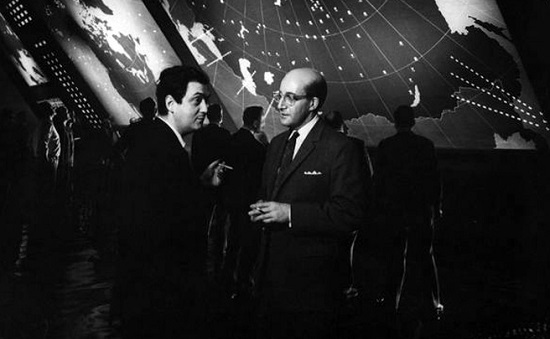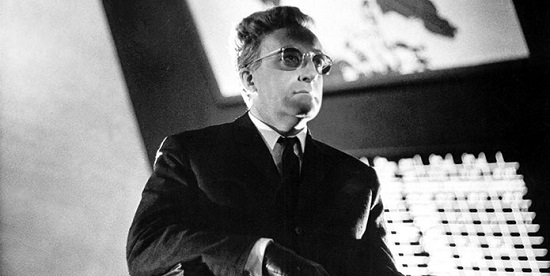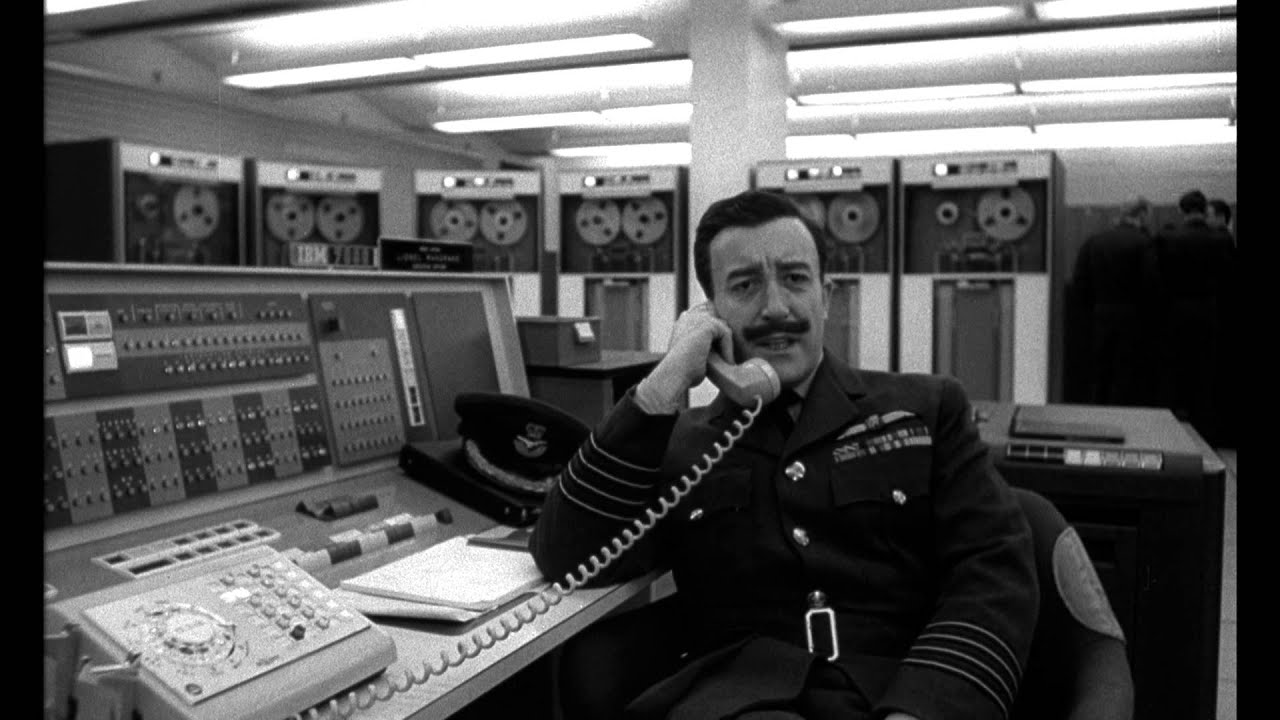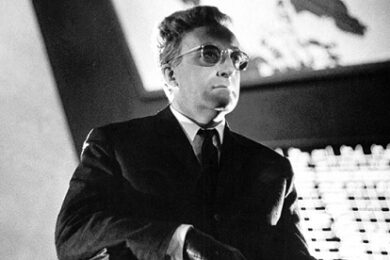When Stanley Kubrick began preparations for his film about nuclear conflict, Dr. Strangelove. Or: How I Learned To Stop Worrying And Love The Bomb (1964), America was only just drawing back from the brink. All the fear, mutual suspicion and paranoia percolating through the 1950s had culminated at the start of the new decade in a stand off over the Berlin Wall and then the Cuban Missile Crisis. It had been less than twenty years since the explosion of the ‘Trinity’ Bomb in the New Mexico desert – signalled by a flash so bright you could have seen it standing on Mars – yet now the superpowers were stockpiling thousands of missiles, each one on average 30 times more powerful than that first detonation. Welcome to the ‘new normal’.
According to Kubrick, one of the most alarming features during this period was what he perceived as a lack of alarm among the American population. ‘We deny the threat and subconsciously experience our anxieties elsewhere,’ he wrote. For him, the only possible solution to nuclear annihilation lay in ‘the mind of man and I don’t think he has even begun to face the problem. With Dr. Strangelove he aimed to provide a wake-up call.
In previous films like Paths of Glory and Spartacus, Kubrick had revealed a fascination with war and its psychological toll, and he would revisit the same themes in Full Metal Jacket. But a film about the Bomb was a different order of magnitude entirely. For one thing, the Bomb is not so much about war as its horrifying terminus. It is both the real and symbolic product of all the wars that have gone before it and all the dead they have carried in their wake. We can think of it as a storage device or hard drive, able to ‘replay’ the whole destructive history of man in a blaze of light and heat, this final act of war erasing war itself. Because of this, any film about the Bomb is not so much about war as its deterrence.
A brilliant chess player, Kubrick was ideally tuned to the Byzantine strategies of nuclear deterrence. He collected dozens of books on the subject, devised by the likes of the RAND Corporation (becoming the BLAND Corporation in Dr. Strangelove), which analysed ways to ‘win’ World War Three, albeit accepting tens of millions of casualties along the way. The paradoxical nature of deterrence was clear to Kubrick from the start. ‘If you are weak, you may invite a first strike,’ he wrote. ‘If you are becoming too strong, you may provoke a pre-emptive strike. It’s almost impossible to maintain the delicate balance because secrecy prevents you from knowing what the other side is doing, and vice versa, ad infinitum.’
How to dramatise such absurdities? Moreover, how to get the audience to acknowledge the unprecedented horrors that constitute the end product of such absurdities without alienating them entirely? It’s interesting to take a quick look at the approach of two other films about nuclear war that emerged at the same time as Dr. Strangelove – Sidney Lumet’s Fail Safe (1964) and Peter Watkins’ The War Game (1965).
Fail Safe has some compelling moments, in particular Henry Fonda as a Capraesque president forced to drop the Bomb on New York to even up the score after the US accidentally blows up Moscow. It shares some strikingly similar content to Dr. Strangelove, but it’s too dry and insists on too much proselytizing, the film ultimately crushed by the gravity of its subject matter. Watkins’ pseudo-documentary The War Game, produced for the BBC, is a brilliant and chilling affair, so chilling in fact that the BBC refused to screen it for 20 years. It has a gruesome realism later seen in a film it clearly influenced, and which holds a special place in the nightmares of any kid born in the 1970s, namely Mick Jackson’s Threads.
Dr. Strangelove inhabits a space somewhere inbetween, utilizing documentary techniques and realistic visual modes, but as the director himself put it, spiked with ‘irreverent, vicious, satirical comedy’. For Kubrick, nuclear war had begun to assume the qualities of a ‘hideous joke’, so a black comedy was a perfect fit. It helped that he had the services of Peter Sellers, who takes on three roles in the film – Captain Mandrake, President Muffley and Dr. Strangelove – and whose performances could have earned him three separate Oscars (as it was he received a nomination). George C Scott is a boyish anti-Patton, actually a veiled portrait of Curtis ‘Bombs Away’ LeMay, the head of the USA’s Strategic Air Command. Sterling Hayden plays the psychopathic and comically paranoid Jack D Ripper who believes the Russians are trying to contaminate his “precious bodily fluids” via fluoridation in the water supply, while Slim Pickens is Major TJ Kong, a Texan bomber pilot with a cowboy’s swagger.

With the comedy to soften up the audience, Kubrick takes one of the basic functions of narrative – the hero striving to achieve his goal – and works it from both sides. So in one scene we’re right behind Captain Mandrake as he tries to avert global disaster, and in the next we’re cheering on the bomber pilots fighting against all the odds to drop their nuclear payload. The human urge to survival meets the human urge to destruction in scene after scene, our own complicity laid bare as we are compelled to recognize in the Bomb the echo of our own nature.
Two types of deterrent motivate the plot. Firstly there’s America’s ‘Plan R’, described by General Turgidson as “an emergency war plan in which a lower echelon commander may order a nuclear retaliation after a sneak attack, if the normal chain of command has been disrupted.” The problem being that Jack D Ripper has decided to exploit the significant loophole in this arrangement by mounting a surprise attack on the Soviet Union, his planes heading past their fail safe points to targets in Russia, Turgidson conceding to the president that “the human element seems to have failed us here.”
The elimination of the human element constitutes the basis of the second instance of deterrent in the film, the Soviet’s Doomsday Machine, described by the Russian ambassador as a device designed to trigger itself automatically if any attack is made on the USSR, as well as to explode if any attempt is ever made to un-trigger it. When detonated, the Doomsday Machine will produce a radioactive cloud destined to shroud the earth for 93 years, destroying all human and animal life.
Dr. Strangelove, a wheelchair bound former Nazi, presumably swept up in Operation Paperclip, elaborates on the logic behind the Doomsday Machine: “It is not only possible for it to be triggered automatically but essential. Because of the automated decision-making process it rules out human meddling.” So there’s no risk of conscience getting in the way, sowing seeds of doubt in the strength of the deterrent. Instead the deterrent becomes absolute, non-negotiable. But, as Dr. Strangelove points out, the whole purpose of the Doomsday Machine is lost if you keep it a secret. “It was due to be announced in a few days time,” explains the Russian ambassador, ruefully.
Secrecy works both ways, of course. In an excellent article by Ian Jack on Britain’s renewal of the Trident missile system, he writes that ‘the navy could fill the sharp end of a Trident missile with straw, but if the straw could be kept a perfect secret and the world went on believing there were warheads capable of destroying 266 cities, each the size of Hiroshima, then Trident would be doing its job.’ Front, bluff, swagger, a talent for bullshit – these are the noble virtues when it comes to an effective deterrent. As Ian Jack puts it, ‘if Trident had to be used, it wouldn’t have worked.’
But there are those in Dr. Strangelove who see things differently, who like the RAND Corporation believe that a nuclear war is winnable, or that we can at least avoid escalation should a shot be fired in anger. In Fail Safe, Fonda tries to play the ‘containment’ game by dropping a nuclear bomb on New York to appease the Soviets. Coming at the film’s end, the audience is left with no idea as to whether this works or not. But in talking about the potential casualties, one adviser arrives at a figure of around 10 million dead. That’s the equivalent of a 9/11 every single day for eight years. Now think about the military reaction to 9/11. If each bomb brings death and destruction on an unprecedented scale, the reaction itself is bound to be unprecedented. This is even before considering the psychotic atmosphere that would have to prevail in order to fire off a nuclear missile in the first place. In such circumstances, ‘containment’ soon starts to seem like a pipe dream.
The only way out of the paradox of nuclear war lies in the ‘mind of man’ said Kubrick, and to fully appreciate the brilliance of Dr. Strangelove, we need to know that when he said it, it was men specifically he was referring to. The sublimation of sex and sexual anxiety are everywhere in the film. It’s obvious right from the start, where mid-air refueling sees the thick metal rod from a supply plane being inserted into a B52 bomber, all done to an instrumental version of ‘Try A Little Tenderness’. It’s the reason behind Jack D Ripper’s pre-emptive strike, believing as he does that the Russians are somehow tampering with his potency, all the while chomping on a tumescent cigar. For General Turgidson weaponry provides the perfect lexicon for sex, while Dr. Strangelove offers titillating descriptions of nuclear war’s aftermath, where politicians deep in mineshafts will need harems of beautiful women in order to begin repopulating the earth as quickly as possible. If we were left in any doubt about the subtext, the film’s climax is just that – Major Kong riding a nuclear missile like a giant multi-megaton cock, whooping and howling with joy as he prepares for the monstrous explosion between his legs.
As the film plays out to footage of mushroom clouds accompanied by Vera Lynn’s ‘We’ll Meet Again’, the vertiginous, apocalyptic strangeness of the ‘new normal’ rolls over like a blast wave once again – more than 50 years since Dr. Strangelove was made, the presence of the Bomb remains just as abnormal as ever. But still, you can’t help laughing. Admittedly, it’s starring-pop-eyed-into-the-void kind of laughter, laughter that edges into madness, but it’s laughter all the same.
Then you think about how soon we might be living in a world where the nuclear balance is held between Vladimir Putin and Donald Trump. At that moment the laughter abruptly dries up.
Dr Strangelove is available to buy on Blu-ray from Criterion now




